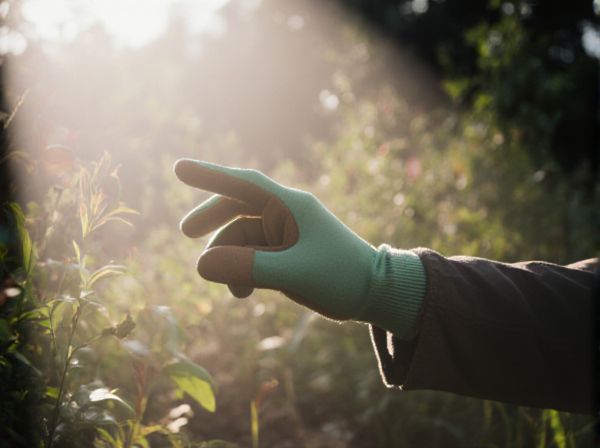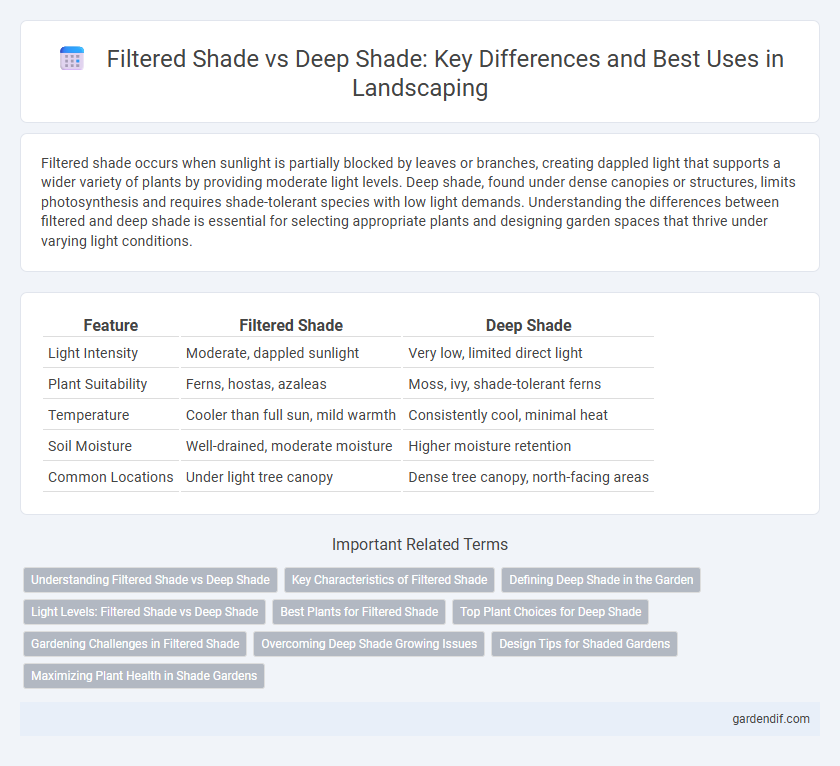
filtered shade vs deep shade Illustration
Filtered shade occurs when sunlight is partially blocked by leaves or branches, creating dappled light that supports a wider variety of plants by providing moderate light levels. Deep shade, found under dense canopies or structures, limits photosynthesis and requires shade-tolerant species with low light demands. Understanding the differences between filtered and deep shade is essential for selecting appropriate plants and designing garden spaces that thrive under varying light conditions.
Table of Comparison
| Feature | Filtered Shade | Deep Shade |
|---|---|---|
| Light Intensity | Moderate, dappled sunlight | Very low, limited direct light |
| Plant Suitability | Ferns, hostas, azaleas | Moss, ivy, shade-tolerant ferns |
| Temperature | Cooler than full sun, mild warmth | Consistently cool, minimal heat |
| Soil Moisture | Well-drained, moderate moisture | Higher moisture retention |
| Common Locations | Under light tree canopy | Dense tree canopy, north-facing areas |
Understanding Filtered Shade vs Deep Shade
Filtered shade occurs when sunlight passes through a canopy of leaves, allowing dappled light to reach plants beneath, typically providing about 40-70% sunlight. Deep shade, characterized by less than 40% sunlight penetration, exists under dense tree cover or structures, resulting in significantly reduced light for understory plants. Understanding these differences is crucial for selecting shade-tolerant species and optimizing garden designs for appropriate light levels.
Key Characteristics of Filtered Shade
Filtered shade occurs when sunlight passes through a canopy of leaves, producing dappled light that varies in intensity throughout the day. This type of shade provides moderate protection from direct sun, allowing plants to receive intermittent sunlight, which is essential for species that thrive in partial light conditions. Filtered shade maintains cooler soil temperatures and preserves higher humidity levels compared to deep shade, creating an ideal microenvironment for shade-tolerant plants.
Defining Deep Shade in the Garden
Deep shade in the garden refers to areas that receive less than two hours of direct sunlight daily, often found beneath dense tree canopies or beside tall buildings. Plants thriving in deep shade must adapt to low light conditions, relying on filtered shade or indirect light for photosynthesis. Understanding the specific light intensity and duration is crucial for selecting shade-tolerant species that sustain healthy growth in these environments.
Light Levels: Filtered Shade vs Deep Shade
Filtered shade allows moderate light levels, typically ranging from 2,000 to 5,000 foot-candles, creating a dappled sunlight effect ideal for plants requiring partial sun. Deep shade reduces light to less than 1,000 foot-candles, producing a consistently low-light environment suitable for shade-loving species. Understanding these light levels helps gardeners select plants based on their specific photosynthetic light requirements and growth potential.
Best Plants for Filtered Shade
Filtered shade provides dappled sunlight ideal for plants like hostas, ferns, and astilbes that thrive in indirect light conditions. These plants benefit from moderate light exposure, which supports vibrant foliage and consistent blooming without the stress of intense sun. Selecting shade-tolerant species such as bleeding hearts and caladiums can maximize garden health and aesthetics in filtered shade environments.
Top Plant Choices for Deep Shade
Top plant choices for deep shade include hostas, ferns, and astilbes, which thrive in low light conditions due to their shade-tolerant foliage and growth habits. Shade-loving groundcovers like pachysandra and sweet woodruff provide dense coverage while minimizing soil erosion in deep shade areas. Tree understory plants such as hellebores and Solomon's seal adapt well to filtered and deep shade environments, making them ideal for heavily shaded garden spots.
Gardening Challenges in Filtered Shade
Gardening in filtered shade poses unique challenges due to variable light levels that can fluctuate throughout the day, affecting photosynthesis and plant growth. Plants in filtered shade may experience inconsistent moisture retention, leading to either drought stress or fungal issues, which complicates irrigation strategies. Selecting shade-tolerant species adapted to partial light, such as hostas or ferns, is crucial for thriving garden beds under filtered canopy conditions.
Overcoming Deep Shade Growing Issues
Plants growing in deep shade face challenges such as limited photosynthesis and reduced growth rates due to minimal light availability. Using shade-tolerant species with larger leaves and slower growth cycles can improve survival in these conditions. Enhancing soil fertility and ensuring adequate moisture supply helps overcome nutrient competition and stress in deep shade environments.
Design Tips for Shaded Gardens
Filtered shade environments allow some sunlight to penetrate through tree canopies, making them suitable for a wider variety of shade-tolerant plants such as hostas, ferns, and astilbes. Deep shade areas receive minimal direct sunlight, requiring plants with exceptional shade tolerance like mosses, ivy, and hellebores, emphasizing the need for careful plant selection to ensure healthy growth. Incorporating layered plantings, reflective surfaces, and textured foliage enhances visual interest in both filtered and deep shade garden designs.
Maximizing Plant Health in Shade Gardens
Filtered shade provides intermittent sunlight that supports photosynthesis, promoting stronger plant growth and vibrant foliage. Deep shade limits light availability, requiring shade-tolerant species with low light needs to maximize plant health. Proper soil moisture and nutrient management further enhance plant resilience in varying shade conditions.
filtered shade vs deep shade Infographic

 gardendif.com
gardendif.com